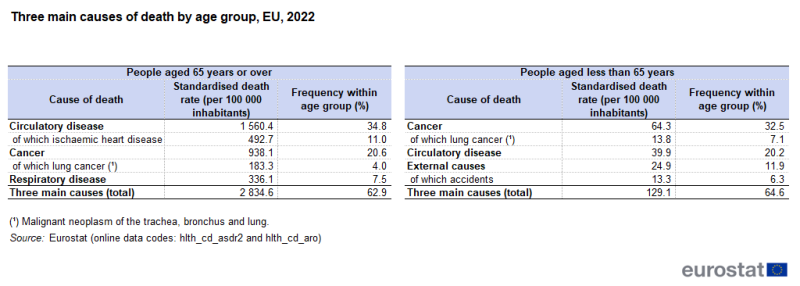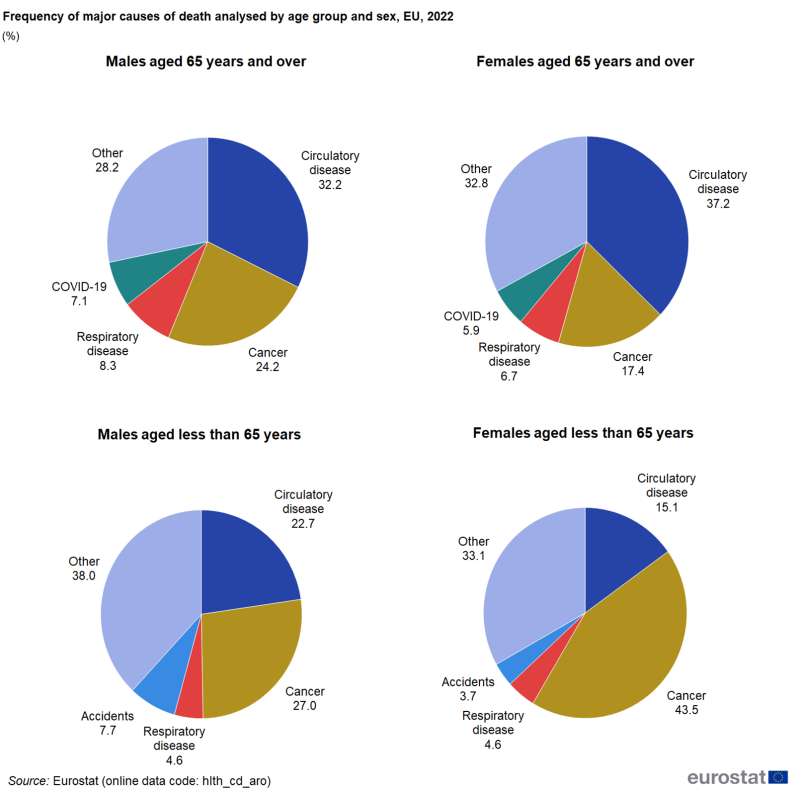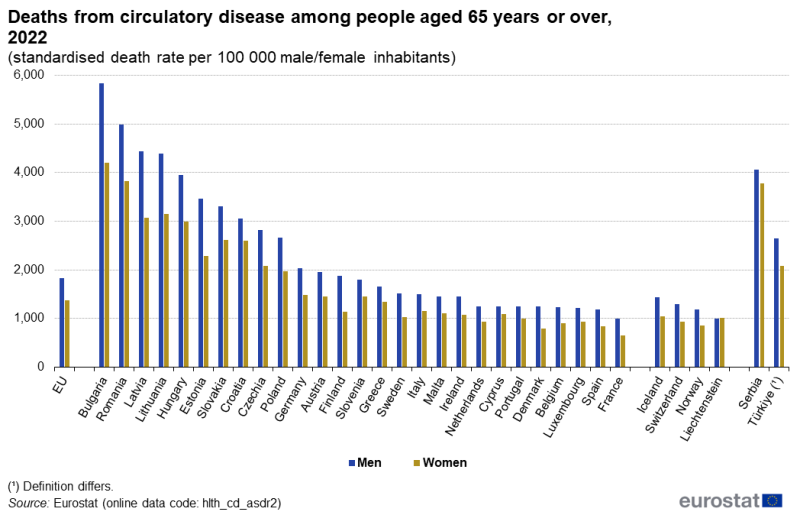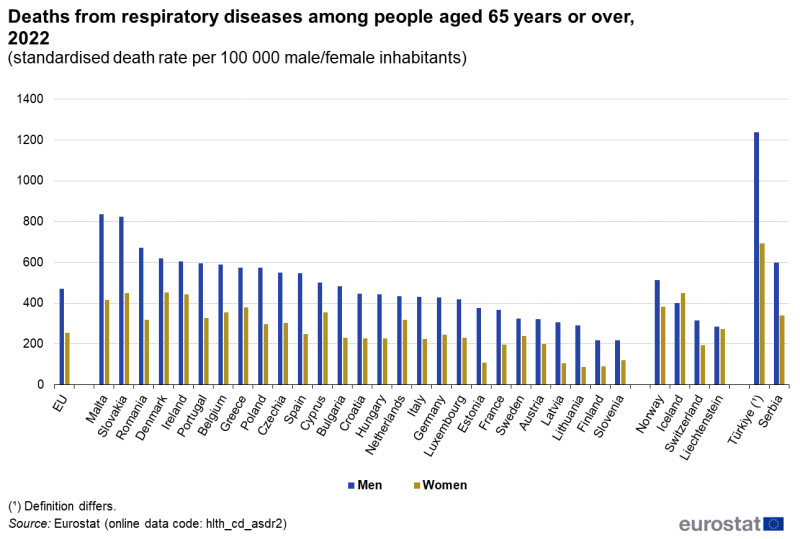Data extracted in April 2025.
Planned article update: April 2026.
Highlights
Among older people (aged 65 years or over), the standardised death rate from circulatory diseases in 2022 was higher for men than for women in all EU countries.
In 2022, the lowest standardised death rate from circulatory disease among people aged 65 years or over was reported in France and the highest in Bulgaria.
In the population aged less than 65 years, the highest standardised death rate from COVID-19 among EU countries in 2022 was reported for Bulgaria. The highest rates among older people were in Bulgaria and Greece and the lowest in Denmark and Sweden.
Standardised death rate for deaths from circulatory diseases by age group, 2022
This article uses the most recent statistics on causes of death in the European Union (EU). It is important to identify and record the underlying reasons for deaths and make this information available to policymakers, health services and the public. With these data, it’s possible to describe and understand the rate and trends in Causes of death.
The data also serve to give information on changing epidemiological circumstances. Most causes of death vary significantly by age and by sex. This article gives an overview of standardised death rates for the EU as a whole and for EU countries with analyses by country of residence, age and sex of the deceased. The use of standardised death rates facilitates comparisons both over time and between countries, independently of different population age structures.
This article is included in a set of statistical articles concerning health status in the EU which forms part of an online publication on Health in the European Union – facts and figures.
Most frequent causes of death in the EU in 2022
In the EU, there were 5.2 million deaths of residents in 2022. Among these, 4.4 million (85.3% of the total) occurred among people aged 65 years or over (hereafter referred to as elderly people); the remaining 760 000 deaths were among people aged less than 65 years. The principal causes of death and their related death rates differ between these age groups.
Just over a third (34.8%) of all deaths in the EU’s elderly population in 2022 were caused by diseases of the circulatory system (see Table 1). Nearly 1 in 3 of these (or 11.0% of all deaths) were caused by ischaemic heart disease. The 2nd most frequent cause of death among elderly people was cancer, accounting for just over a fifth (20.6%) of all deaths. The 3rd most common cause of death among elderly people were respiratory diseases, accounting for 7.5% of all deaths among elderly people.
Among residents of the EU aged less than 65 years, the 2 leading causes of mortality were reversed: cancer was the most frequent cause of death, accounting for almost 1 in 3 (32.5%) deaths in this age group; diseases of the circulatory system were the 2nd most frequent cause of death (20.2% of the total). They were followed at some distance by external causes of death with share of 11.9% (of which more than half were accidents).

Source: Eurostat (hlth_cd_asdr2) and (hlth_cd_aro)
Analyses by sex and age of the most frequent causes of death in the EU in 2022
In the EU, circulatory diseases were a more frequent cause of death among elderly women than among elderly men. This disease accounted for 37.2% of all deaths among elderly women in 2022 and 32.2% of all deaths among elderly men – see Figure 1. The reverse situation was observed in 2022 for 3 other leading causes of death. Cancer accounted for 17.4% of all deaths among elderly women and 24.2% among elderly men. Respiratory diseases [1] accounted for 6.7% of all deaths among elderly women and 8.3% among elderly men. COVID-19 accounted for 5.9% of all deaths among elderly women and 7.1% among elderly men.
Among EU residents aged less than 65 years who died in 2022, cancer was the principal cause of death for 43.5% of females and 27.0% of males (see Figure 1). Circulatory diseases accounted for 15.1% of all deaths among females aged less than 65 years compared with 22.7% among males of the same age. The 3rd and 4th most common causes of death among people aged less than 65 years were the same for males and females, but in different orders. Accidents accounted for 7.7% of all deaths among males (3rd highest) aged less than 65 years, compared with 3.7% among females (4th highest). Respiratory diseases were the 4th most common cause of death among males aged less than 65 years and the 3rd most common among females, with a 4.6% share in both cases.

Source: Eurostat (hlth_cd_aro)
Standardised death rates higher among elderly people for most causes of death
Figure 2 shows standardised death rates beyond the 4 most common causes of death among elderly people (circulatory disease, cancer respiratory disease and COVID-19 as presented in the top half of Figure 1). For these other leading causes of death, EU rates are shown in Figure 2 for the whole population, people aged 65 years or over and people aged less than 65 years.
The standardised death rates in 2022 were higher among elderly residents in the EU than among younger residents for all the other causes; there are 3 exceptions not shown in Figure 2. These exceptions were pregnancy, childbirth and the puerperium, certain conditions originating in the perinatal period, and congenital malformations, deformations and chromosomal abnormalities.
Following on from the 4 most common causes already identified in Figure 1, the next most common cause of death among elderly people in the EU was symptoms, signs and abnormal clinical and laboratory findings, not elsewhere classified. This residual category includes cases when a definitive diagnosis hasn’t been established or when a condition is described by its symptoms (such as fever, respiratory arrest) or other abnormal findings. In 2022, the standardised death rate for this condition was 17 times as high for elderly people as for people aged less than 65 years. Conditions with particularly large relative age gaps included diseases of the genitourinary system (where the rate for elderly people was 73 times as high as that for younger people), mental and behavioural disorders (45 times as high) and diseases of the skin and subcutaneous tissue (44 times as high). By contrast, the age gap was narrower for diseases of the digestive system (the rate for elderly people was 10 times as high as that for younger people) and external causes of morbidity and mortality (6 times as high).

Source: Eurostat (hlth_cd_asdr2)
Standardised death rates by country
The standardised death rate from circulatory disease in 2022 was higher among elderly men than elderly women in all EU countries (see Figure 3). The highest standardised death rates from circulatory disease among elderly men and elderly women were reported in Bulgaria, followed by Romania.
France was the only EU country to report a standardised death rate from circulatory disease among elderly men below 1 000 deaths per 100 000 male inhabitants in 2022, while rates below this level were reported for elderly women by 7 EU countries. In 2022, the lowest standardised death rates from circulatory disease within the elderly population were reported by France, 998 deaths per 100 000 male inhabitants and 646 deaths per 100 000 female inhabitants.

Source: Eurostat (hlth_cd_asdr2)
In 2022, the standardised death rate from cancer among people aged 65 years old or over was higher among men than women in all EU countries (see Figure 4). Croatia and Latvia recorded the highest standardised death rate from cancer among elderly men with over 1 700 deaths per 100 000 male inhabitants. Luxembourg was the only country to record less than 1 000 deaths from cancer per 10 000 men aged 65 or over. Among elderly women, Denmark and Hungary recorded over 900 deaths from cancer per 100 000 female inhabitants aged 65 or over. There were 4 countries: Portugal, Spain, Cyprus and Bulgaria, which reported less than 600 deaths from cancer per 100 000 elderly female inhabitants.

Source: Eurostat (hlth_cd_asdr2)
In 2022, the standardised death rate from respiratory disease among people aged 65 years old or over was higher among men than women in all EU countries (see Figure 5). The highest standardised death rate from respiratory diseases in among elderly men in the EU was recorded in Malta and Slovakia, with 837 and 825 deaths per 100 000 elderly male inhabitants, respectively. Among elderly women the highest rates were recorded in Denmark and Slovakia, both with over 450 death per 100 000 elderly female inhabitants. The lowest rates of respiratory diseases were recorded in Finland (140 per 100 000 inhabitants) and in Lithuania (153 per 100 000 inhabitants). In those countries the lowest rates from respiratory diseases among elderly women were also recorded (Finland - 89 per 100 000 inhabitants, Lithuania - 88 per 100 000 inhabitants).

Source: Eurostat (hlth_cd_asdr2)
Among those aged 65 years and over, the highest standardised death rates from COVID-19 in 2022 among the EU countries were recorded in Bulgaria, Slovenia and Greece for men (see Figure 6); for women, the highest rates were among the same countries, but with the highest rate in Greece, followed by Bulgaria and Slovenia. Equally, the lowest rates both for elderly men and for elderly women were observed in Denmark and Sweden.
In all EU countries, the standardised death rate from COVID-19 was higher in 2022 among elderly men than among elderly women. Nevertheless, the range in this ratio was quite narrow (compared with some other causes of death): the largest gender difference was in Estonia, where the rate for elderly men was 2.3 times as high as that for elderly women, while the ratio was lowest (1.4 times as high) in Ireland.

Source: Eurostat (hlth_cd_asdr2)
Developments over time
Men aged 65 years or over
Between 2012 and 2022, the EU standardised death rate of cerebrovascular disease for elderly men decreased by more than a quarter (down 29%). Decreases of around a fifth were observed for, ischaemic heart disease (down 21%), colorectal cancer (down 19%) and lung cancer (down 18%). Among the 5 causes of death shown in Figure 7 which recorded overall declines, the smallest decrease in the standardised death rate was for prostate cancer (down 12%).
By contrast, the EU standardised death rate of dementia for elderly men increased by over a third (up 34%) between 2012 and 2022, despite a 10% decrease between 2018 and 2021. The EU standardised death rate of accidents among elderly men increased by 21%, largely due to a 14% increase between 2020 and 2022. An increase of 7% was observed for the EU standardised death rate of diabetes mellitus among elderly men.

Source: Eurostat (hlth_cd_asdr2)
Women aged 65 years or over
Figure 8 shows standardised death rates for selected major causes of death among elderly women in the EU between 2012 and 2022.
The largest decrease was observed for cerebrovascular disease, which fell by 30% across the EU, similar to the fall observed for elderly men. The rate for ischaemic heart disease for elderly women decreased by 26%; as such, the overall decline for elderly women was larger than that observed for elderly men. The rate for colorectal cancer was down 18% for elderly women, also similar to the fall observed for elderly men. For breast cancer, the decrease was relatively small, down 3% overall, largely due to a fall in 2021. A similar decrease was observed for diabetes mellitus (down 5%), reflecting falls in the 2 most recent years, after an increase in 2020 which had almost reversed the decreases accumulated since 2012.
The EU standardised death rate for accidents among elderly women increased 20% between 2012 and 2022, similar to the rise observed among elderly men. In contrast to the situation observed among elderly men, the standardised death rate for lung cancer increased every year among elderly women with an overall increase of 25%. Similar to the situation observed among elderly men, the largest increase observed among elderly women was for dementia, up 37%; a 12% increase in 2022 more than offset the falls observed in the 3 previous years.

Source: Eurostat (hlth_cd_asdr2)
People aged less than 65 years
The EU standardised death rate for people aged less than 65 years fell by 10.9% between 2012 and 2022 (see Table 3). Larger than average decreases were noted for each of the 3 main causes of death. The standardised death rate for cancer fell 23.6%, that for circulatory diseases fell 20.3% and that for accidents fell 13.5%.

Source: Eurostat (hlth_cd_asdr2)
Source data for tables and graphs
Data sources
Statistics on the underlying causes of death provide information on mortality patterns. This source is documented in more detail in a background article on the methodology of causes of death statistics which provides information on the scope of the data, its legal basis, the methodology employed, as well as related concepts and definitions.
Legal basis for the data collection
Since the 2011 reference year, reporting countries have submitted data to Eurostat based on the requirements of Regulation (EC) No 1338/2008 on Community statistics on public health and health and safety at work, and Regulation (EU) No 328/2011 on Community statistics on public health and health and safety at work, as regards statistics on causes of death. For data before the 2011 reference year, countries submitted data to Eurostat based on a gentlemen’s agreement established within the context of Eurostat’s Working Group on Public Health Statistics.
There are currently 33 countries submitting data on the causes of death to Eurostat:
- all 27 EU countries
- 4 EFTA countries (Iceland, Liechtenstein, Norway and Switzerland)
- 2 candidate countries (Serbia and Türkiye).
National and regional (NUTS level 2) data are collected.
Classification of the causes of death
Statistics on the causes of death are based on medical information provided in death certificates. Causes of death are classified by the 86 causes in the European shortlist which is based on the International Classification of Diseases and Related Health Problems.
When the COVID-19 pandemic started, the World Health Organization (WHO) introduced emergency codes in the ICD version 10 (ICD-10) that countries could use to report deaths from COVID-19. In Eurostat’s dissemination database, the codes are available as follows:
- U071 – COVID-19, virus identified (deaths where COVID-19 has been confirmed by laboratory testing)
- U072 – COVID-19, virus not identified (COVID-19 virus not identified)
- U_COV19_OTH – COVID-19 other (COVID-19 death not elsewhere defined).
The data for COVID-19 reported in this article were calculated by adding the data for these 3 codes, however the data disseminated in Eurostat’s dissemination database are for each separate code. More information about ICD-10 codes can be found on the WHO’s website.
Standardised death rate
The number of deaths from a particular cause of death can be expressed relative to the size of the population. A standardised death rate is adjusted to a standard age distribution. This facilitates comparisons of rates over time and between countries. The European standard population used for the standardisation of crude rates is based on the European Standard Population in use since summer 2013.
Context
Statistics on causes of death are among the oldest medical statistics available. They provide information on developments over time and differences between countries in causes of death. These statistics play a key role in the general information system relating to the state of health in the EU. They may be used to determine which preventive and medical-curative measures or which investments in research might increase the life expectancy of the population.
Statistics concerning causes of death among people aged 65 years or over (referred to in this article as elderly people) are of increasing interest. A dramatic change in the nature and delivery of healthcare over the past century has resulted in much longer life spans and a greater prevalence of chronic illnesses. In turn, this has led to increased demand on healthcare systems, particularly for long-term care. Public health programmes throughout the EU are often targeted at reducing mortality among people aged less than 65 years through preventive measures, for example, the promotion of healthier lifestyles through improved nutrition, lower tobacco and alcohol consumption, an increase in physical activity or a reduction of workplace risk.
According to Eurostat’s 2023 baseline year projections, the share of the population aged 65 years or over in the EU is projected to increase relatively rapidly to 27.5% of the total population by 2042 and then to 30.0% by 2059 before increasing more slowly to 32.5% by 2100; in 2024, the share was 21.6%.
Footnotes
- Data on respiratory diseases don’t include COVID-19. ↑
Explore further
Other articles
Online publications
Causes of death
- Causes of death statistics
- Causes of death – monthly statistics
- Preventable and treatable mortality statistics
Health status
Specific health conditions
- Accidents and injuries statistics
- Cardiovascular diseases statistics
- Cancer statistics
- Cancer statistics – specific cancers
- Respiratory diseases statistics
- Mental health and related issues statistics
Methodology
General health statistics articles
Database
- Health (hlth)
- Causes of death (hlth_cdeath)
Thematic section
Selected datasets
- Health (t_hlth)
- Causes of death (t_hlth_cdeath)
Methodology
- Causes of death statistics (ESMS metadata file – hlth_cdeath_sims)
- Causes of death statistics manual – 2025 edition
- Revision of the European Standard Population – Report of Eurostat’s task force – 2013 edition
